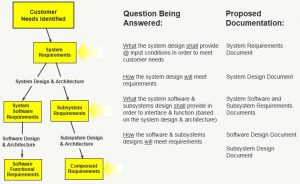
Managing requirements for complex systems can be challenging, however, establishing a hierarchical framework of key questions (answered at each layer of the hierarchy) can be quite helpful.
While some regulatory authorities (such as the FAA) may require various layers of documentation and traceability, this article isn’t necessarily advocating a bureaucratic development process. The process can be scaled based on the complexity of your system, your ability to model it’s (system) design performance and/or based on the amount of product development risk the organization is willing to assume.
Your system design process may therefore forgo a hierarchical and layered approach, however:
Recognizing the process of requirements-design-requirements and system breakdown structures can be quite useful
This is highlighted in the following graphic:
Let’s use a vehicle transmission as an example, which would be a subsystem in a complex system (an automobile). Let’s also assume the transmission is provided by a supplier to the automobile manufacturer.
The automobile design and architecture determines vehicle weight, includes an engine with a certain horsepower/torque curves, and use-cases which are known based on customer needs and system-level requirements. This is valuable information to properly answer the question “What shall the transmission design provide (output to the drive shaft) at input conditions (from the engine and operator)”. Notice we’re treating transmission requirements as if we drew a ‘dotted line’ around the subsystem, and we’re focusing our requirements on the output / input. Transmission requirements therefore ensures the transmission functions and interfaces with the automobile (system) design and architecture and meets overall needs of the system and customer. See article “When the system is the customer”
Regarding subsystem (transmission) design, a transmission designer determines how the design will meet the requirements (features, materials, etc..). Note the use of the word “will” here…details about how the design will function, which forms the basis for the transmission component requirements and so on. (Also, answering the “how will” question lends itself to design review, while “what the design shall provide” lends itself to requirements review by the system designer or customer. In general, this makes requirements and design easier to understand.)
(At the next layer of hierarchy, transmission design processes, and component requirements processes, might overlap using a CAD system (which both designs and specifies component requirements/tolerances). Also, it is likely transmission designs have been perfected over the years and a significant amount of design and component re-use is exercised.)
Answering the key questions “what” and “how” in the framework of a system breakdown structure can help ensure a successful integrated system.

 Ask a question or send along a comment.
Please login to view and use the contact form.
Ask a question or send along a comment.
Please login to view and use the contact form.
Leave a Reply